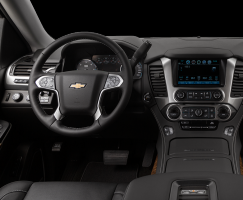
— A GM brake vacuum pump lawsuit alleges Cadillac, Chevrolet and GMC vehicles have problems with the brake boosters and hard brake pedals as part of defective braking systems.
Included in the proposed class-action lawsuit are all consumers who purchased or leased in California one of the following General Motors vehicles:
- 2015 to present Cadillac Escalade
- 2014 to present Chevrolet Silverado
- 2015 to present Chevrolet Suburban
- 2015 to present Chevrolet Tahoe
- 2014 to present GMC Sierra
- 2015 to present GMC Yukon/Yukon XL
Plaintiffs Scott Peckerar and Samantha Peckerar purchased a new 2017 Chevy Suburban in January 2017, but by April the dealer found an oil leak and diagnosed the problem as a failed vacuum pump. The dealer replaced the vacuum pump assembly, gaskets and hardware for free under warranty.
On April 5, 2018, Samantha Peckerar was driving and says she pressed the brake pedal but the pedal became hard and she couldn't stop the vehicle, resulting in a collision with the vehicle in front of her.
General Motors sent an investigator to check the Suburban and couldn't find any evidence of problems after examining the electronic data. The plaintiff says GM told her she should read the manual to understand how the brakes worked, then she was allegedly asked to sign a release for any claims of liability against GM or its dealerships.
The plaintiff says GM told her the front bumper would be repaired as long as she promised confidentiality.
The plaintiffs say they weren't happy that GM found nothing wrong with the braking system, so they took the Chevy to the dealer to test the vehicle.
“Body shop advised that after applying and releasing the brake pedal and then re-applying immediately after for panic stop that brake pedal felt hard and vehicle did not stop as designed… drove vehicle verified after second or third brake application that the pedal gets hard and the brake assist fails to provide assist.”
According to the lawsuit, the cause of the collision was confirmed to be a second failure of the vacuum pump, with the repair order stating:
“SLOW TO BUILD VACUUM BACK UP, REC VACUUM PUMP REPLACEMENT AND RETEST. … ALSO SCAN TEST FOUND Code C025E brake booster sensor circuit/not plausible stored in the EBCM. … Verified with GM technical assistance code C025E 5A is related to low vacuum. … REPLACED VACUUM PUMP ASSEMBLY. CLEARED CODE.”
The plaintiff says this is proof GM's repairs don't work because drivers still have trouble stopping the vehicles because the braking systems lose vacuum. The plaintiffs say GM chooses to put financial gain over customer safety by concealing the defective vacuum pumps and braking systems.
The lawsuit also alleges GM has known about the braking dangers based on technical service bulletins (TSBs) sent to dealerships.
In February 2015, GM issued TSB PIT5361B that said, “a customer may comment on a hard brake pedal or that increased effort is needed to depress the brake pedal." Dealers were allegedly told, “While performing normal diagnostics, fluid may be found in the brake booster and/or the booster vacuum line.”
GM's technical service bulletins allegedly contain false and misleading information for technicians and consumers because the repairs made by dealers allegedly do nothing to fix the vacuum pump problems.
The GM brake vacuum pump lawsuit was filed in the U.S. District Court for the Central District of California - Scott Peckerar and Samantha Peckerar, et al., v. General Motors LLC.
The plaintiffs are represented by Cory Watson, P.C., Kiesel Law LLP, Wyly - Rommel, PLLC, and Beasley Allen.




